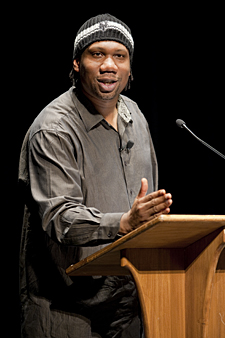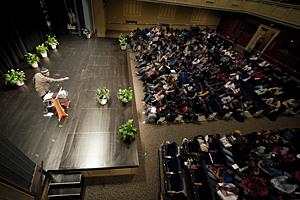- Rozovsky wins prestigious NSF Early Career Award
- UD students meet alumni, experience 'closing bell' at NYSE
- Newark Police seek assistance in identifying suspects in robbery
- Rivlin says bipartisan budget action, stronger budget rules key to reversing debt
- Stink bugs shouldn't pose problem until late summer
- Gao to honor Placido Domingo in Washington performance
- Adopt-A-Highway project keeps Lewes road clean
- WVUD's Radiothon fundraiser runs April 1-10
- W.D. Snodgrass Symposium to honor Pulitzer winner
- New guide helps cancer patients manage symptoms
- UD in the News, March 25, 2011
- For the Record, March 25, 2011
- Public opinion expert discusses world views of U.S. in Global Agenda series
- Congressional delegation, dean laud Center for Community Research and Service program
- Center for Political Communication sets symposium on politics, entertainment
- Students work to raise funds, awareness of domestic violence
- Equestrian team wins regional championship in Western riding
- Markell, Harker stress importance of agriculture to Delaware's economy
- Carol A. Ammon MBA Case Competition winners announced
- Prof presents blood-clotting studies at Gordon Research Conference
- Sexual Assault Awareness Month events, programs announced
- Stay connected with Sea Grant, CEOE e-newsletter
- A message to UD regarding the tragedy in Japan
- More News >>
- March 31-May 14: REP stages Neil Simon's 'The Good Doctor'
- April 2: Newark plans annual 'wine and dine'
- April 5: Expert perspective on U.S. health care
- April 5: Comedian Ace Guillen to visit Scrounge
- April 6, May 4: School of Nursing sponsors research lecture series
- April 6-May 4: Confucius Institute presents Chinese Film Series on Wednesdays
- April 6: IPCC's Pachauri to discuss sustainable development in DENIN Dialogue Series
- April 7: 'WVUDstock' radiothon concert announced
- April 8: English Language Institute presents 'Arts in Translation'
- April 9: Green and Healthy Living Expo planned at The Bob
- April 9: Center for Political Communication to host Onion editor
- April 10: Alumni Easter Egg-stravaganza planned
- April 11: CDS session to focus on visual assistive technologies
- April 12: T.J. Stiles to speak at UDLA annual dinner
- April 15, 16: Annual UD push lawnmower tune-up scheduled
- April 15, 16: Master Players series presents iMusic 4, China Magpie
- April 15, 16: Delaware Symphony, UD chorus to perform Mahler work
- April 18: Former NFL Coach Bill Cowher featured in UD Speaks
- April 21-24: Sesame Street Live brings Elmo and friends to The Bob
- April 30: Save the date for Ag Day 2011 at UD
- April 30: Symposium to consider 'Frontiers at the Chemistry-Biology Interface'
- April 30-May 1: Relay for Life set at Delaware Field House
- May 4: Delaware Membrane Protein Symposium announced
- May 5: Northwestern University's Leon Keer to deliver Kerr lecture
- May 7: Women's volleyball team to host second annual Spring Fling
- Through May 3: SPPA announces speakers for 10th annual lecture series
- Through May 4: Global Agenda sees U.S. through others' eyes; World Bank president to speak
- Through May 4: 'Research on Race, Ethnicity, Culture' topic of series
- Through May 9: Black American Studies announces lecture series
- Through May 11: 'Challenges in Jewish Culture' lecture series announced
- Through May 11: Area Studies research featured in speaker series
- Through June 5: 'Andy Warhol: Behind the Camera' on view in Old College Gallery
- Through July 15: 'Bodyscapes' on view at Mechanical Hall Gallery
- More What's Happening >>
- UD calendar >>
- Middle States evaluation team on campus April 5
- Phipps named HR Liaison of the Quarter
- Senior wins iPad for participating in assessment study
- April 19: Procurement Services schedules information sessions
- UD Bookstore announces spring break hours
- HealthyU Wellness Program encourages employees to 'Step into Spring'
- April 8-29: Faculty roundtable series considers student engagement
- GRE is changing; learn more at April 15 info session
- April 30: UD Evening with Blue Rocks set for employees
- Morris Library to be open 24/7 during final exams
- More Campus FYI >>
4:04 p.m., Oct. 16, 2009----Whether it was talking about Newtonian physics, how Napoleon was the first great graffiti artist or President Ronald Regan's skills as a DJ, emcee and producer KRS-One left no stone unturned as he addressed a packed house at Mitchell Hall about the “Fundamentals of Hip-Hop” on Wednesday night.
Before delving into the specifics of his lecture, KRS-One, the stage name of Lawrence Krishna Parker, proclaimed that “this is a historical night, and here's why: What we are discussing, the fundamentals of hip-hop, is not really discussed in the university environment, the collegiate environment, the academic environment.”
KRS-One conceded that there are hundreds of colleges that teach hip-hop courses, but that they tend to get it wrong -- not wrong as in inaccurate, but wrong in the sense of “immature to mature.”
The main way that these courses, and many history of hip-hop books get it wrong, according to KRS-One, is that they try to document hip-hop from a historical, physical perspective when hip-hop is not a physical thing.
Rather, he said, hip-hop is a metaphysical principle, “an energy, a consciousness, it is an awareness, it is a behavior, it is an attitude, that's what hip-hop is. The attitude, the behavior, the collective consciousness produces rap, break dancing, graffiti art, DJ-ing and everything else that comes out of the culture.”
KRS-One went on to proclaim that because hip-hop is not a physical thing, “you cannot document it according to traditional historical methodology,” the main reason for this being that “when history is looked at physically, I'm trapped in my color, my ethnicity, my race. But when history is looked at as first causes, origins, not history yet, when you look at the origin of something, you step out of physical time and space, and you adopt ideas, not physical matter.”
This led into what KRS-One stressed as one of the original and most important effects of hip-hop -- it changed the perception of its people. When two friends are poor and are standing on the corner acknowledging that they are poor, they are always going to be poor. But, as KRS-One explained, when two poor people are standing on the corner and one of them starts rapping and proclaiming that he is the greatest rapper alive, and both he and his friend start to really believe it, then they actually become it.
“When you step into that personality, that personality has powers that come with it. Your psychology, your perception creates the environment you see. If you say 'I am Mark and Mark's reality is what Mark's reality is,' then that's what you'll stay in. If you say, 'I am the M-Ark' then M-Ark has its own reality. If you call yourself something, you will change your perception of the environment you are in.”
KRS-One then discussed how it is important in hip-hop to compliment a friend, to be positive about his rhyming skills and to “big him up” as the greatest rapper alive in order to change the perception of him and get him noticed. “Russell Simmons did it with LL Cool J, Puffy did it with Biggie, Eminem did it with Fifty, Dre did it with Eminem,” he said. “If you keep complimenting your friends, you get rich.”
KRS-One also explained how hip-hop gave value to a lot of things seen as worthless simply by changing the perception of those items, be they the rappers themselves or physical products like Timberland boots or bandanas.
“Back in the Eighties, you could get Timberland's for like $30. This is a construction boot, the Timberland boot. Hip-hoppers took it, used the perceptual ability of hip-hop, and said 'I like that shoe' and this ain't worth $30, it's worth $150. This is what hip-hop is about. They give you lemons, you make lemonade.”
The event was sponsored by the University of Delaware's Cultural Programming Advisory Board.
Article by Adam Thomas
Photos by Evan Krape




